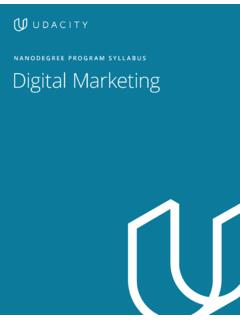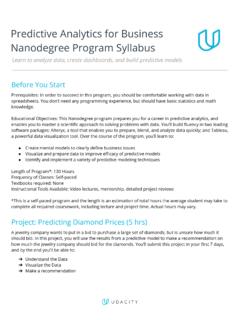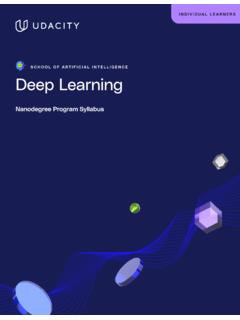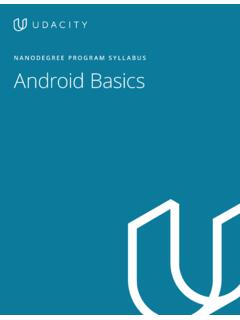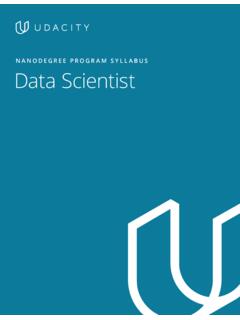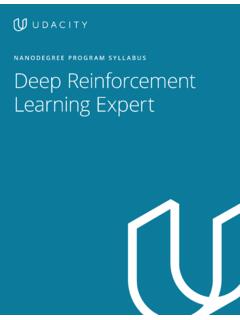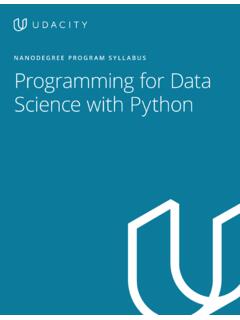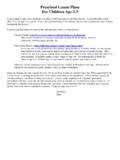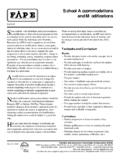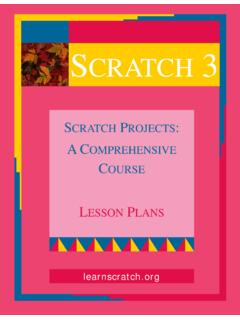Transcription of NANODEGREE PROGRAM SYLLABUS Data Analyst
1 Need Help? Speak with an Advisor: AnalystNANODEGREE PROGRAM SYLLABUSData Analyst | 2 Need Help? Speak with an Advisor: PROGRAM prepares you for a career as a data Analyst by helping you learn to organize data, uncoverpatterns and insights, draw meaningful conclusions, and clearly communicate critical findings. You ll develop proficiency in Python and its data analysis libraries (Numpy, pandas, Matplotlib) and SQL as you build a portfolio of projects to showcase in your job on how quickly you work through the material, the amount of time required is variable. We haveincluded an hourly estimation for each section of the PROGRAM . The PROGRAM covers one term of threemonth (approx. 13 weeks). If you spend about 10 hours per week working through the PROGRAM , you shouldfinish the term within 13 weeks.
2 Students will have an additional four weeks beyond the end of the term tocomplete all order to succeed in this PROGRAM , we recommend having experience working with data inPython (Numpy and Pandas) and : Python & SQL Flexible Learning: Self-paced, so you can learn on the schedule that works best for youEstimated Time: 4 Months at 10hrs/weekNeed Help? Discuss this PROGRAM with an enrollment COLLABORATION WITHData Analyst | 3 Need Help? Speak with an Advisor: 1: Introduction to Data AnalysisLearn the data analysis process of wrangling, exploring, analyzing, and communicating data. Work with data in Python, using libraries like NumPy and OUTCOMESLESSON ONEA naconda Learn to use Anaconda to manage packages and environments for use with Python lesson TWOJ upyter Notebooks Learn to use this open-source web application to combine explanatory text, math equations, code, and visualizations in one sharable documentLESSON THREEData Analysis Process Learn about the keys steps of the data analysis process.
3 Investigate multiple datasets using Python and Project Explore Weather TrendsCourse Project Investigate a DatasetThis project will introduce you to the SQL and how to download data from a database. You ll analyze local and global temperature data and compare the temperature trends where you live to overall globaltemperature this project, you ll choose one of Udacity s curated datasets and investigate it using NumPy and pandas. You ll complete the entire data analysis process, starting by posing a question and finishing by sharing your Analyst | 4 Need Help? Speak with an Advisor: FOURP andas and AND NumPy:Case Study 1 Perform the entire data analysis process on a dataset Learn to use NumPy and Pandas to wrangle, explore, analyze, and visualize dataLESSON FIVEP andas and AND NumPy:Case Study 2 Perform the entire data analysis process on a dataset Learn more about NumPy and Pandas to wrangle, explore, analyze, and visualize dataLESSON SIXP rogramming Workflow for Data Analysis Learn about how to carry out analysis outside Jupyter notebook using IPython or the command line interfaceData Analyst | 5 Need Help?
4 Speak with an Advisor: 2: Practical StatisticsLearn how to apply inferential statistics and probability to real-world scenarios, such as analyzing A/B tests and building supervised learning OUTCOMESLESSON ONES impson s Paradox Examine a case study to learn about Simpson s ParadoxLESSON TWOP robability Learn the fundamental rules of THREEB inomial Distribution Learn about binomial distribution where each observation represents one of two outcomes Derive the probability of a binomial distributionLESSON FOURC onditionalProbability Learn about conditional probability, , when events are not FIVEB ayes Rule Build on conditional probability principles to understand the Bayes rule Derive the Bayes theoremLESSON SIXS tandardizing Convert distributions into the standard normal distribution using the Z-score.
5 Compute proportions using standardized Project Analyze Experiment ResultsIn this project, you will be provided a dataset reflecting data collected from an experiment. You ll use statistical techniques to answer questions about the data and report your conclusions andrecommendations in a Analyst | 6 Need Help? Speak with an Advisor: SEVENS ampling Distributions and Central Limit Theorem Use normal distributions to compute probabilities Use the Z-table to look up the proportions of observations above, below, or in between valuesLESSON EIGHTC onfidence Intervals Estimate population parameters from sample statistics using confidence intervalsLESSON NINEH ypothesis Testing Use critical values to make decisions on whether or not a treatment has changed the value of a population TENT-Tests and A/B Tests Test the effect of a treatment or compare the difference in means for two groups when we have small sample sizesLESSON ELEVENR egression Build a linear regression model to understand the relationship between independent and dependent variables.
6 Use linear regression results to make a TWELVEM ultiple LinearRegression Use multiple linear regression results to interpret coefficients for several predictorsLESSON THIRTEENL ogistic Regression Use logistic regression results to make a prediction about the relationship between categorical dependent variables and Analyst | 7 Need Help? Speak with an Advisor: 3: Data WranglingLearn the data wrangling process of gathering, assessing, and cleaning data. Learn to use Python to wrangle data programmatically and prepare it for OUTCOMESLESSON ONEI ntro to Data Wrangling Identify each step of the data wrangling process (gathering, assessing, and cleaning). Wrangle a CSV file downloaded from Kaggle using fundamental gathering, assessing, and cleaning TWOG athering Data Gather data from multiple sources, including gathering files, programmatically downloading files, web-scraping data, and accessing data from APIs.
7 Import data of various file formats into pandas, including flat files ( TSV), HTML files, TXT files, and JSON files. Store gathered data in a PostgreSQL THREEA ssessing Data Assess data visually and programmatically using pandas Distinguish between dirty data (content or quality issues) and messy data (structural or tidiness issues) Identify data quality issues and categorize them using metrics: validity, accuracy, completeness, consistency, and uniformityLESSON FOURC leaning Data Identify each step of the data cleaning process (defining, coding, and testing) Clean data using Python and pandas Test cleaning code visually and programmatically using PythonCourse Project Wrangle and Analyze DataReal-world data rarely comes clean. Using Python, you ll gather data from a variety of sources, assess its quality and tidiness, then clean it.
8 You ll document your wrangling efforts in a Jupyter Notebook, plus showcase them through analyses and visualizations using Python and Analyst | 8 Need Help? Speak with an Advisor: 4: Data Visualization with PythonLearn to apply visualization principles to the data analysis process. Explore data visually at multiple levels to find insights and create a compelling OUTCOMESLESSON ONEData Visualization in Data Analysis Understand why visualization is important in the practice of data analysis. Know what distinguishes exploratory analysis from Explanatory analysis, and the role of data visualization in TWOD esign ofVisualizations Interpret features in terms of level of measurement. Know different encodings that can be used to depict data in visualizations. Understand various pitfalls that can affect the effectiveness and truthfulness of THREEU nivariate Exploration of Data Use bar charts to depict distributions of categorical variables.
9 Use histograms to depict distributions of numeric variables Use axis limits and different scales to change how your data is interpretedLESSON FOURB ivariate Exploration of Data Use scatterplots to depict relationships between numeric variables. Use clustered bar charts to depict relationships between categorical variables Use violin and bar charts to depict relationships between categorical and numeric variables Use faceting to create plots across different subsets of the dataCourse Project Communicate Data FindingsReal-world data rarely comes clean. Using Python, you ll gather data from a variety of sources, assess its quality and tidiness, then clean it. You ll document your wrangling efforts in a Jupyter Notebook, plus showcase them through analyses and visualizations using Python and Analyst | 9 Need Help?
10 Speak with an Advisor: FIVEM ultivariate Exploration of Data Use encodings like size, shape, and color to encode values of a third variable in a visualization. Use plot matrices to explore relationships between multiple variables at the same time. Use feature engineering to capture relationships between SIXE xplanatory Visulizations Understand what it means to tell a compelling story with data. Choose the best plot type, encodings, and annotations to polish your plots. Create a slide deck using a Jupyter Notebook to convey your SEVENV isulizationCase Study Apply your knowledge of data visualization to a dataset involving the characteristics of diamonds and their Analyst | 10 Need Help? Speak with an Advisor: Classroom ExperienceREAL-WORLD PROJECTSB uild your skills through industry-relevant projects.
